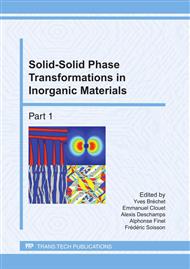p.658
p.664
p.670
p.676
p.682
p.691
p.697
p.703
p.709
Transmission Electron Microscopy Study of Microstructural Evolution in Nanograined Ni-Ti Microwires Heat Treated by Electric Pulse
Abstract:
Transmission electron microscopy and mechanical testing were employed to investigate the evolution of microstructure and functional superelastic properties of 0.1mm diameter as-drawn Ni-Ti wires subjected to a non-conventional heat treatment by controlled electric pulse current. This method enables a finer control of the recovery and recrystallisation processes taking place during the heat treatment and accordingly a better control on the final microstructure. The best functional properties were obtained for heat-treated Ni-Ti wires having a nanograined microstructure (20-50 nm) partially recovered through polygonization and partially recrystallized. Such microstructure is highly resistant against dislocation slip upon cycling, while microstructures annealed for longer time and showing mostly recrystallized grains were prone to dislocation slip, particularly as the grain size exceeds 100 nm. The density of dislocation defects increased significantly with increasing grain size of the microstructure. The activity of three <100>/{011} slip systems was identified in the largest grains of 500-1200 nm. An additional mode of plastic deformation, {114} compound austenite twinning, was observed in the largest grains of fully recrystallized microstructures. It is proposed that dislocation slip (and possibly deformation twinning) occurring in superelastic cycling is coupled with the stress-induced martensitic transformation.
Info:
Periodical:
Pages:
682-687
Citation:
Online since:
June 2011
Authors:
Price:
Сopyright:
© 2011 Trans Tech Publications Ltd. All Rights Reserved
Share:
Citation:


